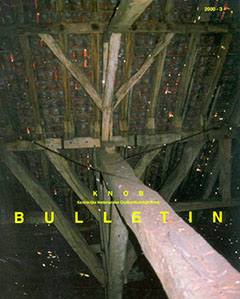Indexering ESCI / Scopus


Inleiding bij het themanummer (D.J. de Vries). C.A.M. van Rooijen: De datering van de Heilig-Kruiskapel te Utrecht. E.H.P. Cordfunke: De tombe van graaf Floris V te Alkmaar. Dirk J. de Vries: Vergelijkend natuurwetenschappelijk dateringsonderzoek. U. Sass-Klaassen: Drendrochronologisch onderzoek aan naaldhout uit Nederlandse monumenten.
From the preceding it will be clear that an 8th-century dating for the Heilig- Kruiskapel at Domplein in Utrecht cannot be maintained. All dating methods used to date the Heilig-Kruiskapel point to a period after the middle of the 8th century at the earliest. In view of the 14C calibration, the stratigraphy of the wallwork and the ground-levels connected with this, a dating in the 10th century, preferably at the end of it, is most likely.
Consequently, it may be concluded that the 10th-century dating for the Heilig-Kruiskapel ascertained by A.E. van Giffen in the thirties of the...
The 'tomb' of count Florence V of Holland in the ‘Grote Kerk’ (St. Laurentius church) of Alkmaar has a remarkable history which can be summarized as follows. After his assassination in 1296 the body of Florence V was carried to the church of Alkmaar where it was placed in the choir, and stayed there for almost a year before it was buried in the abbey of Rijnsburg. The intestines, however, remained in the church of Alkmaar, and a donation for a memory chapel was made to commemorate the count.
When in 1414 the amount of this donation was fixed again, the place where the intestines...
For the first time in the Netherlands a start was made — besides dendrochronology (d) and in comparison with it - with thermoluminescence (TL) datings of brick and 14C datings (14C) of wood and organic material contained in mortars. In this summary the methods as well as the most accurate results will be assessed.
The oldest stages of the churches at Garnwerd (1229 ± 3 d), Oosterwijtwerd (1237 ± 5 d) and Marsum (1306 ± 6 d) could be ascertained by means of dendrochronology. The roof of the church at Britsum proved not to be older than 1464 ± 5 years, while the brick of the...
Fir (Albies alba) can be dendrochronologically analyzed and dated without problems. This applies for wood from monumental buildings as well as for wood from archaeological excavations. Sometimes a few to possibly some ten years of difference occurs between the dating of fir and oak from the same context, as well as between spread datings of fir from one context. This may point to a longer period of transport or storage of the fir used in the Netherlands, in comparison with the usually freshly processed oak. Spruce is only rarely found in monumental buildings, but was used in combination...


open access mogelijk gemaakt door Stichting OpenAccess
